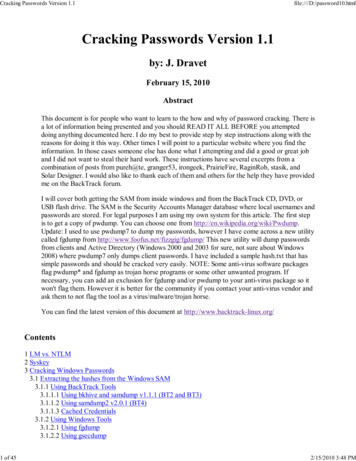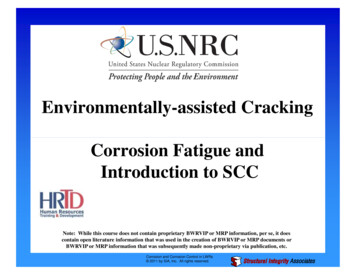
Transcription
ProductPricesBRM contentAbout usCRACKINGTHESALESMANAGEMENTCODEJASON JORDAN WITH MICHELLE VAZZANASUMMARIZED BY
Cracking the SalesManagement CodeCracking the Sales Management Code by Jason Jordan and Michelle Vazzana is a must-read for sales professionals. It is based on Jason Jordan’sbelief that sales management is a science. In order to boost profits, salesmanagers need a sales strategy with actionable steps that can be monitored with the right sales metrics. The book is based on his research and experience in managing the sales forces of top companies.IntroductionAll sales team wants to sell more.And in the 21st century, sales teams have turned to CRM which promise toautomate sales activity, aggregate data and nurture leads.However, Jordan believes that having the right CRM is not enough. Themodern sales manager has data right at their fingertips, and they shouldknow how to use this to transform data into sales.If you want to learn how to craft a science-based and research-backedsales strategy, then we recommend Cracking the Sales Management Code:The Secrets to Measuring and Managing Sales Performance by Jason Jordan and Michelle Vazzana.No time to finish a 250-page book? We know that sales managers have abusy schedule so we’ve summarized this ultimate sales resource below.
Table of Contents1. Sales Then and Now2. Sales Metrics: Manageable vs Unmanageable3. Activities, Objectives & Results: Manageable or Not?4. 5 Types Of Sales Processes5. Which Sales Process Is Right For Your Business?6. Know Your Sales Objectives7. Putting It All Together8. The Challenge for Sales Managers
1. Sales Then and NowWhat is the sales management code?The book begins with an explanation of how the sales industry has changed in recentyears.In the good ‘ol days, sales speaker Neil Rackham believed that there were only threethings sales managers need to succeed: Selection: recruiting highly-skilled salespeople Strategy: creating a sales plan that can help them attract and retain accounts Skills: training them in the art of persuasive sales callsA long time ago, recruiting the right people and making as many sales calls would guarantee your victory, however, times have changed.The modern sales process features fancy CRM tools and detailed reports with tons ofnumbers and sales metrics. It’s easier than ever to share resources with your partnersand get in touch with potential prospects through social media.Sad thing is, despite all this, sales management does not have a framework or trainingmanual. While you have all the tools, which methodologies will help you sell more?In the book’s prologue, Neil Rackham writes that the modern sales industry requiresthree M’s: Management: managing your sales team Metrics: identifying metrics that align sales activities with sales goals Methodology: formulating and executing a precise and methodological strategySuccessful sales don’t happen by chance.Sales managers must be trained to identify metrics and formulate methodologies sotheir sales teams can sell more.To prove this, Jordan partnered with the Sales Education Foundation. His team askedsales leaders to submit a list of metrics which help them monitor and improve their salesperformance.By aggregating a grand total of 306 sales metrics, Jordan hoped that he could categorize these metrics in such a way that they can function as pulleys and levers that controla sales force.4
2. Sales Metrics: Manageable vs UnmanageableMetrics like customer retention and number of calls measure sales activities and salesresults.We know that they’re somehow connected and Jordan’s goal was to understand therelationship between these different metrics.How to start this insurmountable task? He asked one question:How ‘manageable’ is this metric?Jordan believed that sales metrics existed in a spectrum of unmanageable vs. manageable.A manageable metric could be directly influenced by doing something differently and anunmanageable metric could not.Manageable metricA manageable metric is controllable.For example, the number of prospecting sales calls is manageable because a sales manager can instruct a salesperson to make X number of calls per day. The number ofsales reps per manager is also manageable because executives can easily change theamount of people in a team.5
Unmanageable metricAn unmanageable metric is uncontrollable.For example, revenue is influenced by a variety of factors like market demand, manufacturing and economy.If you lived in a sales utopia, you can easily aim for 1 million in profits. Unfortunately,the amount of revenue you target is influenced by a lot of factors that are out of yourcontrol.3. Activities, Objectives & Results:Manageable or Not?We know sales metrics are either manageable or unmanageable so how is this useful?Jordan started painting the big picture. He categorized the 306 metrics into 3 main categories based on their manageability below. Sales Activities: metrics can be managed and controlled at will. Sales Objectives: metrics can be influenced by managing sales activities Sales Results: metrics cannot be managed although the results can be influencedby managing sales activities and sales objectives.Let’s discuss how he arrived at this conclusion.Sales ActivitiesSales Activities are manageable because a sales manager can easily change the activities of their sales force.Here are some examples: Time Spent Coaching Reps Number of Call Plans Completed Number of Calls Made per Day6
Sales ObjectiveSales objectives are the goals of the sales team.Sales objective can be found in the middle of the spectrum of manageable vs. unmanageable. It doesn’t take a genius to figure out why.If you want to aim for Revenue X, then you need to set objectives to help you reach yourdesired goal. These objectives will determine the sales activities that you need to makein the future.Here are some examples: Percentage of Customer Retention Percentage of Target Customers Contacted Number of New Customers AcquiredBusiness resultsBusiness results are the result of everything that you did.Sure, profits can be influenced by sales objectives and sales activities. Unfortunately,you can’t control it and it can change based on many factors like marketing, manufacturing, finance and competition.Here are some examples: Revenue Revenue Growth Revenue per Sales RepConnecting the dotsNow that we’ve categorized them based on manageability, how can you connect thedots?Their relationships are quite simple:Sales activity (manageable) - Sales objective (can be influenced) - Sales results(unmanageable)7
This simple graphic shows that sales results might be out of our control but the numbers you get can be managed through sales activities which are influenced by salesobjectives.If you’re having trouble understanding how this causal chain looks, here’s a real-lifeexample:4. Types of Sales ActivitiesWe can’t control revenue so let’s focus on the stuff that we can control — sales activities.The sales activities you perform are be based on your company, industry and customers.There are so many sales activities, however, there’s no framework of activities that willget your sales team to where you want them to be. There are no building blocks that tellyou how things work.8
Most sales managers make-up their own strategies and tell their salespeople: SELLMORE!They say you have to work smart, not just work hard — and the same is true for sales. Astudy by CSO Insights found that sales teams with a defined sales plan won 53% of theirforecasted deals, and only 43% were won by those that used informal process.Sadly, only 60% of salespeople said they used informal processes and lacked a salesmethodology.Jordan believed that the sales activities in every sales plan functioned as commandoptions. If you knew the right buttons to push, then you can forge a path to success. Astudy by CSO Insights even found that sale processes could help salespeople sell 23%more.To make sense of sales activities he categorized them into five groups that we bet you’refamiliar with:9
Call management processThe call management process is used to improve the quality of sales calls.The call management process entails getting sales reps to prepare for important calls.That means call-planning exercises where salespeople can set clear objectives, anticipate the buyer’s response and brainstorm alternatives when deals don’t go as planned.After their assigned calls are done, salespeople must have a debriefing session withtheir sales managers. They then break down the positive and negative outcomes of theconversations — and how they can do better in the future.Take a look at this template for sales call plans:10
Here are some examples of sample metrics: Number of Calls Made % of Reps that Completed Call Plans Percentage of Reps Using Designated Scripts and/or Email TemplatesOpportunity ManagementOpportunity management is used when a sales team must qualify, plan and analyze asingle multistage sales pursuit.This is used when companies have to bid and compete to score a profitable deal with bigcompanies. It’s also a preferable sales activity when organizations want to strategicallyanalyze the profitability of potential customers, instead of saying yes to every opportunity.For example, a salesperson may qualify opportunities by collecting information aboutthe customer’s profile, revenue, annual reports, industry authority and credibility.Here’s how an opportunity management process looks like:This enables salespeople to assess which opportunities will get them closer to their desired business results.11
Here are some sample metrics: Win Rate % of Qualified Opportunities Opportunities by StageOpportunity managers can use the template below to evaluate each opportunity:Territory ManagementTerritory management is used when salespeople target customers based on a set of attributes or sales territory. A sales territory can be a defined industry, size or geography.This sales process allocates managers in such a way that they can meet face-to-facewith the most number of qualified customers. This means salesperson A may focus onacquiring customers in city A while salesperson B may focus on acquiring customers incity B.12
Since customer demographics and psychographics may differ based on their territory,this sales activity requires customer segmentation. A sales manager may then designcustomer call patterns that are personalized for each customer segment.Here are some sample metrics: Number of Meetings per Year Number of Customers per Rep % of Contact with New BuyersTake a look at this target call pattern from the book:In the example above, the number of sales reps per customer segment could be basedon profitability. An organization may assign more sales reps for national accounts andlarge companies because it could offer higher profitability. Meanwhile, less salespeopleare assigned to handle smaller companies because of lower profitability.Account ManagementAccount management’s objective is to increase revenue from a select group of customers.This sales activity is a must when a significant portion of an organization’s revenue comes from a select group of buyers.13
It starts with the creation of an account strategy that aligns a company’s needs with theneeds of its select customers.Companies then coordinate their external and internal resources to improve or maintainthe value of the account. Some activities include engaging in face-to-face meetings tobuild the relationship and negotiating contracts to maximize profits.Here are some examples: Share of Wallet Percentage of Account Plans in Place Percentage of Account Plans Complete.A Key Account Plan is often used to establish strategic goals for each account:14
Sales Force EnablementSales Force Enablement activities are used to improve how salespeople do their job.This process includes investing a lot of money in providing coaching, training and resources to boost the capability of a sales force. It may also consider assessing performance based on various methodologies and tools.Here are some metrics: Average Cost of Training by Salesperson Average Level of Satisfaction with Sales Training Time Spent CoachingWhile companies pour a lot of money in education, they also want to hire determinedand skilled salespeople. So, sales force enablement also emphasizes recruitment andhiring efforts.5. Which Sales Process Is Right For YourBusiness?We’ve introduced several sales processes but which one is right for your business?Most businesses will probably use a mix of several sales processes, while others mightwant to try them all. Sales managers don’t want their team to perform different activities or projects that they start to lose focus.That’s why Jordan believed that an assigned sales processes is determined by the rolesand responsibilities of each selling role.This makes a lot of sense because each sales process is characterized by a different setof metrics. For instance, a salesperson in a call management role assesses performancethrough a different set of metrics as compared to account managers or territory managers.We bet that there are lots of sales process used by sales teams but there’s no need to beintimidated. Pinpointing the ideal sales process begins through identifying the sellingroles in your sales force.Here are some guidelines that you can use to find out the right process for each salesperson:15
Call ManagementCall management is used when a sales call has a big impact on closing a sale.If a salesperson makes low to moderate number of significant calls, then use this process to plan conversations ahead and achieve your desired outcome.Opportunity ManagementOpportunity management is used when a salesperson pursues strategic and multistagedeals.Since a company’s time and resources are precious, some organizations engage in these activities to qualify multistage opportunities before pursuing them.Account ManagementAccount management is used when a salesperson wants an ongoing business relationship with a customer.It’s no secret that some accounts are worth more than others. That’s why this is usedwhen a company must maintain customer relationships because they provide huge benefits and sizeable profits.Territory ManagementTerritory management is used when customers are segmented.Each segment has different characteristics, so territory management is necessary whenan organization needs to implement different strategies for each type.To succeed through this process, a sales team must widen their market reach. So, thisrequires them to manage their time wisely and make as many calls as possible.Sales Force EnablementSales Force Enablement is used when the company makes managing decisions suchas recruiting, organizing, coaching, training and resource allocation to improve salesperformance.Once you’ve chosen a sales process, examine its alignment with your organization’sneeds and salespeople’s responsibilities. Pick the process that will help your team accomplish their sales goals.16
6. Know Your Sales ObjectivesHow do you achieve your desired sales results?They say you should work smarter, not harder — and the same applies in sales.To recap, the researchers categorized sales metrics based on their manageability:Sales activity (manageable) - Sales objective (neutral) - Sales results (unmanageable)The image shows that you can’t manage sales results.Fortunately, you can manage sales activities and we’ve identified the sales processesthat you can control — Account Management, Opportunity Management, Call Management, Territory Management and Sales Force Enablement.These activities are highly manageable but they must be aligned with your business'objectives to make an impact on your desired results.For example, your Sales Objective could be to upsell a premium line of upgraded products to past customers.This could be achieved through sales activities like training sales reps and managingaccounts. It’s not strategic to sell your premium products at random. However, you canset an objective and opt to contact current accounts and train sales reps to sell better.The bottomline is: Managing Sales Activities Helps You Fulfill Your Sales Objectives.Types of Sales ObjectivesSales Objectives might not be completely manageable, but they come with a set ofmeasurable metrics.It may seem intimidating to determine your sales objectives when you know they have abig impact on sales results. However, Jordan believes that you can identify your objectives based on the metrics that you want to focus on.Jordan’s team of researchers found that objectives could be classified into four maintypes.17
Market CoverageMarket Coverage objectives determine your sales force’s capability and resources tocover the market thoroughly. Your target market coverage can impact hiring decisions,number of sales calls and recruitment.Sample metrics include: Measures of Market Coverage Number of Total Selling Hours Percentage of Customers ContactedSales Force CapabilitySales Force Capability objectives explore a sales teams effectivity in closing more deals.The amount of calls and opportunities pursued can have a direct impact on the numberof deals won.We all know that a sales team’s capability can improve with the right mentorship andtraining. So, Sales Force Enablement activities like coaching and assessments belongin this category.Sample metrics include: Proposal Win Rates Percentage Deals Advancing by Stage (2) Pipeline Realization RateCustomer FocusCustomer Focus objectives delve into your sales team’s ability to attain, retain and increase your ideal number of customers. A sales team may qualify or disqualify customers based on their location and profitability.Here are some examples of customer focus metrics: Customer Churn Rate Customer Lifetime Value Repeat Purchase RateProduct FocusProduct Focus objectives determine the effectiveness of your salesforce in selling yourpreferred products.For instance, account managers could create strategies to upsellproducts to their existing clients.18
It could also be used to evaluate a sales team’s success in selling a new line of products.Here are some examples of product focus metrics: Revenue by Product Revenue by Product Line Average Cross-sell and Upsell Rate of Partner CustomersCombining Sales Processes & Sales ObjectiveJordan believes that your sales objectives will influence the sales activities that yourteam will perform.For instance, an Opportunity Management Process aligns with objectives like CustomerFocus and Product Focus because you aim to choose strategic relationships that willpay off over time. However, it’s not suitable for goals related to Market Coverage because this process focuses on getting as many customers as possible to cover the entireterritory.Now, how can you determine which sales activities align with your sales objectives?Jordan has a chart that shows how certain sales processes drive specific objectives.Want to expand your market coverage? Focus on territory management and sales force enablement. How will your sales team improve your account management process?Take a look at customer focus and product focus.19
7. Putting It All TogetherThe book has consistently emphasized AOR metrics such as the following: Sales Activities Sales Objectives Sales ResultsNow, how do they all come together?Jason Jordan found that these metrics are interconnected.To reach your sales goals, you must devote time to planning your sales activities andsales objectives.While sales revenue may be out of your control, you can focus on the sales activities thatyou can control.Jordan’s analysis makes a lot of sense, but its implementation may seem daunting forfirst-time readers. Fortunately, Jordan summarized how to crack the sales management code through a simple 6-step process: Define the Business Results you want. Identify and analyze the Sales Objectives that will help you achieve your desiredSales Results. Select Sales Processes that can impact your Sales Objectives. Determine Sales Activities within those processes that you can manage on a dailybasis. Set quantified targets and metrics to monitor your chosen Activities, Objectivesand Results. ManageThere may be different types of sales management jobs like Area Sales Manager andGeneral Sales Manager but the path to success is the same.An organization must specify their Activities, Objectives and Results in their sales plan.This way, you can make sense of the various numbers that you get every month/quarter/year.20
8. The Challenge for Sales ManagersThe sales management code seems easy and formulaic in theory.However, experienced sales managers will know that its implementation comes with afew challenges.The first challenge is that sales managers need to determine the Sales Objectives thatthey will target. Some may focus on a sales territory though they may have a hard timedeciding whether to attract current customers or identify new prospects. There’s noharm in choosing to do a little of both, but choosing a lot may lead to a lack of focus.The second challenge is to choose metrics to measure the performance of each salesreps. This can be a tedious task for large sales teams with different roles and job descriptions. Although the ability to monitor and adjust their sales activities, will pay off inthe long-run.Another challenge is that different sales role may use different sales processes, pursuedifferent objectives and require different metrics. Some reps may focus on increasingmarket coverage while others are assigned to focus on a specific product.While this can be a challenge for sales executives, Jason Jordan proposed that companies should train sales managers to develop their own AOR metrics (activities, objectives and results) on the field.An ideal sales manager must be highly skilled in creating AOR frameworks. When sales managers can determine relevant metrics for every employee, they can ensure thatevery effort aligns with the objectives and desired results of the organization.Get your free ebookObjective SettingDone RightDownload now21
About usQollabi helps you to build stronger relationships with your businesspartners. We call our software BRM: Business Relationship ManagementSoftware.We especially developed it for professionals managing indirect saleschannels like agents, branches, distributors, dealers, brokers, resellersetc.Our customers choose Qollabi BRM because of increased commitmentand accountability. Both, within their own organization as between themand their business partners. Want to know more? Discover what Qollabican do for you.Ask a DemoFeaturesFollow us22
Cracking the Sales Management Code Cracking the Sales Management Code by Jason Jordan and Michelle Vaz-zana is a must-read for sales professionals. It is based on Jason Jordan's belief that sales management is a science. In order to boost profits, sales managers need a sales strategy with actionable steps that can be monito-










